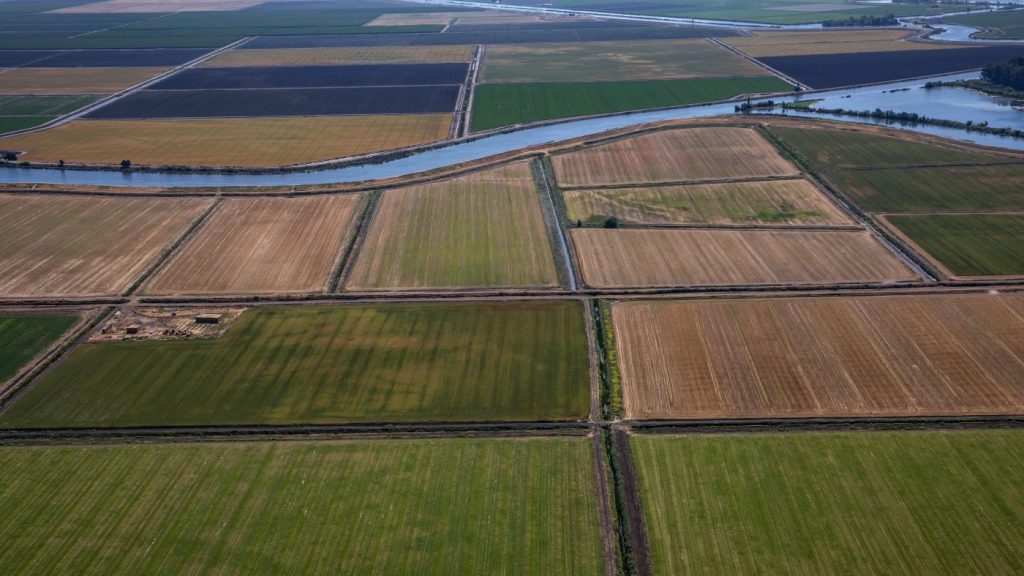The effects of climate change in central California's agriculture hub are causing such massive increases in irrigation needs that yearly water usage now equals the capacity of the region's biggest reservoir, as per a recent study.
California's San Joaquin Valley is among the most productive farming areas globally. most productive farming regions in the world the journal PLOS Water.
Describing the situation as water vanishing without notice, Joshua Viers, a professor at the University of California Merced School of Engineering, said, "It's water that's effectively disappearing."
The valley is crucial for global fruit and nut production due to its Mediterranean climate, providing a majority of the world's almonds, pistachios, and processing tomatoes.
In a region facing a dwindling water supply, the crops require significant irrigation from both surface and groundwater sources, with the latter being overused for over a hundred years in some areas, according to the authors.
"There's a dynamic tension between supply and demand," Viers stated. He further explained that the Mediterranean climate leads to a disconnect in water availability due to wet winters and hot, dry summers, which affects both time and space.
Attributing the supply variability to the Mediterranean climate, he explained that wet winters and hot, dry summers create an inherent "disconnect between water availability." That disconnect applies both in time and space, with the most precipitation occurring in areas "far removed from the principal demands in cities and farms."
Nonetheless, the San Joaquin Valley's agricultural production remains "a key driver of the regional economy and important contributor to the nation's food supply," according to a 2023 brief from the Public Policy Institute of California. according to a 2023 brief from the Public Policy Institute of California.
A 2023 policy brief estimated that by 2040, average annual water supplies could drop by 20 percent and result in the loss of up to 50,000 jobs and the fallowing of nearly 900,000 acres in a worst-case scenario.
Despite the region's groundwater levels declining for a century, the pace of shrinkage "has accelerated in the past two decades," according to the Wednesday study.
"This acceleration of groundwater depletion coincided with multi-year to multi-decadal droughts that have been among the most extreme in a millennium," the authors stated.
To determine the extent of crop water loss in recent decades, the scientists used climate data and "crop coefficients" — ratios used to calculate the total water loss a plant experiences.
They found that increasing demand could account for around half of the total deficits in the region's agricultural water balance since 1980, leading to greater reliance on depleting groundwater supplies and unstable imports.
Naming this phenomenon an "invisible water surcharge," the scientists discovered that from 2012-2023, such demand rose by 4.4 percent compared to a 1980-2011 baseline.
This means there is an yearly increase of 717.9 gigaliters, which is more than the 690-gigaliter capacity of the Millerton Lake Reservoir in San Joaquin Valley, according to the study.
Viers said that it's basically an extra payment due to human activity.
When added together over the 12-year study period, this demand goes beyond the storage capacity of the valley’s five largest reservoirs, the researchers pointed out.
The authors mentioned that managing water sustainably is crucial in the southwestern U.S. due to the pressures of climate change and excessive allocation of water resources.
However, they cautioned that the hidden water surcharge puts the sustainability of fruit, nuts, and vegetable production at risk, while increasing the industry’s reliance on decreasing groundwater, reduced snowpack, and unpredictable water imports.
They concluded that the growing water demands have become a threat to the sustainability of these industries, and necessitate changes in management and policies to account for the changing hydroclimate.
Viers suggested that one possible solution for the area is to use more precise irrigation or switch to crops that can withstand drought better. For instance, he mentioned that some farmers in the San Joaquin Valley have started cultivating agave — the desert plant used to make tequila.
He also mentioned the possibility of growing certain water-intensive crops, like alfalfa, only during part of the year, which could be beneficial.
Referring to the rise in demand over the previous decade, Viers stated, "Although 4.4 percent may not seem like a lot, it actually adds up to a substantial amount of water due to the large area of the San Joaquin."
He added that it has a significant impact on the American grocery basket.









